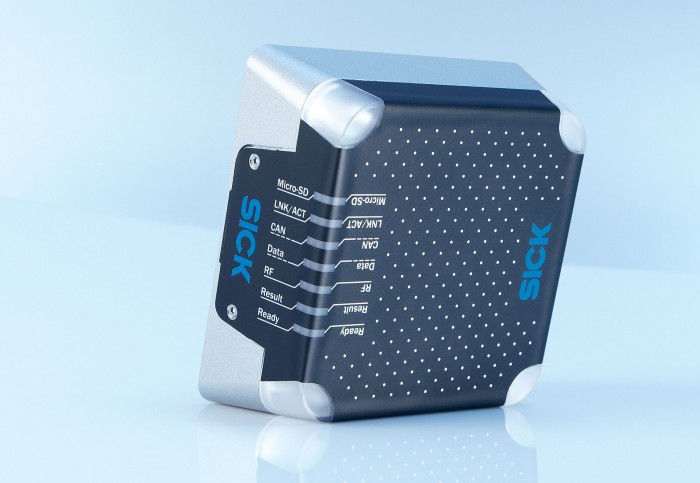SICK AG introduces its new RFID reading gate system

Photo by Sick AG
The flow of goods and information not only plays a major role in distribution logistics, but also in returns management. Those who always know exactly where what goods are increase their process transparency and thus have a clear advantage – this is true for both the logistician and customers. RFID tags are used here: their data can be read out, modified and re-written. Comprehensive information in the normal process between the supplier and customer can be stored on the RFID tag; e.g. the delivery note, order form, etc., not merely saving paper, but also valuable personnel working time. The great advantage and, simultaneously, the challenge of RFID technology is that large numbers of containers can be read at the same time and nearby tags must not be allowed to interfere.
The RFGS (Radio Frequency Gate System) RFID reading gate allows such multiple reading and is optimized for stacks on pallets – at maximum reading rates and with other such systems nearby. In the case of the RFMS (Radio Frequency Modular System) RFID tunnel, tag reading takes place on the product level within the multiple packaging system. SICK has solved the high complexity of the application requirements through integration in these two systems.
RFGS Pro: integrated sensor intelligence – a system solution
The RFGS Pro offers all the advantages of reliable identification of incoming and outgoing goods. RFID tags are filtered via the intelligent allocation algorithm: goods that are located in the vicinity of the gate, but are not to be allocated, are filtered out. This enables a precise identification of the actual incoming or outgoing goods – including the detection of direction.
The RFGS Pro (Radio Frequency Gate System) track-and-trace system is a flexible and intelligent complete solution for incoming and outgoing goods in logistics – for optimizing processes in the delivery chain. The system consists of proven solutions from SICK: read/write units for identification via RFID, a central controller with integrated allocation algorithm and a 2D laser scanner for detecting objects, speed and direction. This enables unambiguous decentralized allocation of the RFID tags at the gate. False positives are suppressed without costly licensed software. Simple and economical commissioning is possible in site thanks to the robust standard industrial mechanics and the installation wizards integrated in the SOPAS from SICK.
New UHF read/write device uses Power over Ethernet (PoE)
The RFU620: compact solution for short ranges
The new small RFU620 UHF RFID read/write unit offers a solution when identification of containers, boxes or the correct aisle is involved. As an intelligent identification system, it supports universal use even in extreme applications (e.g. on stackers and in deep-freeze stores), or simply as a Kanban station.
With its new RFU620 read/write device, SICK has supplemented its UHF portfolio with an optimized read/write device for medium ranges and limited installation space. Numerous filter functions and a range of connection variants enable the creation of versatile identification solutions.
Like its big brother the RFU630, the RFU620 operates within a frequency range of 860 – 960 MHz. Unlike this device, however, it is optimized for applications in which UHF transponders meeting the worldwide ISO/IEC standards must be reliably identified at medium ranges and in close physical proximity to one another. The SOPAS user interface offers tools for rapid, flexible and simple integration.
Optimized field geometry, wide range of filter functions
The RFU620 offers the possibility of adjusting the transmission power up to a range of one meter and thus adapting to the particular reading situation. The antenna of the read/write unit generates a homogeneous and symmetrical communication field that provides targeted reading out and writing of the individual transponders. The RFU620 can use its adaptive power control function to autonomously increase transmission power until a transponder can be read. This prevents the simultaneous detection of several transponders. Other filter functions focus communication on transponders with particular data structures or a particular minimum transmission strength, or prevent the multiple detection of the same transponders within a definable time period. All this ensures reliable data transmission behavior in both reading and writing cycles.
New: integration via Power over Ethernet
The RFU620 is used, for example, for container and storage space identification in intralogistics. The compact housing is particularly helpful for use on fork-lift trucks because the read/write unit offers space-saving location between the lifting forks. The interface and fieldbus standards common in these sectors (including RS232/422, Ethernet TCP/IP, EtherNet/IP, CANopen, PROFIBUS DP and PROFINET IO) are, for the first time, supplemented with the integration option of Power over Ethernet (PoE). There is therefore no need for an additional power supply when setting up, for example, simple RFID Kanban stations. The device is ready for operation with a single cable connection to a PoE network. In information terms, therefore, the RFU620 also offers the familiar amount of future-orientation – particularly as the new read/write device is completely compatible with IDpro, SICK’s cross-technology platform and portfolio strategy for auto-ID system solutions.
The SICK visualization platform detects and stores all the captured data in a database and offers comprehensive search and statistical functions for their evaluation.
For more information, please visit http://www.sick.com.
News Categories
- » NEWS HOME
- » Automation & Robotics
- » Industry 4.0
- » Material Handling
- » Sensors
- » Quality & Testing
- » Machine Vision
- » Laser & Optics
- » Metalworking
- » Motion Control & Drives
- » Hydraulics & Pneumatics
- » Process Industry
- » Renewable Energy
- » Agriculture
- » Home & Office Furniture
- » Environmental Tech

